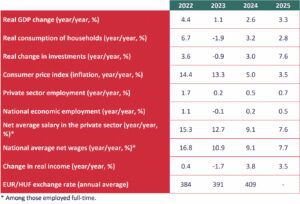Economic forecast – Autumn 2022
ACCORDING TO THE ANALYSIS OF THE EQUILIBRIUM INSTITUTE, ECONOMIC GROWTH IN HUNGARY WILL BE 4.4 PERCENT THIS YEAR AND 1.1 PERCENT
NEXT YEAR
The top messages of our autumn 2022 forecast:
- Hungarian GDP growth is expected to be 4.4 percent in 2022 and 1.1 percent in 2023. In the second half of this year, the growth of the economy will slow down significantly, primarily as a result of inflation arising from galloping energy prices. An important factor in this year’s growth is consumption brought forward and investment (for example, in the field of energy-saving appliances), which is explained by increased energy prices. In the second half of the year, however, caution will increase in this area as well.
- Households and companies as a whole face the developments of the coming months against a stronger background than in 2009. Household net savings are at a much higher level than in 2009, and the risk arising from foreign currency debt has also disappeared. The companies are also typically in a better condition than in 2009, while the state’s room for manoeuvre is also stronger in several aspects (primarily thanks to its self-financing programme).
- Inflation is expected to be 14.4 per cent in 2022 and 13.3 per cent in 2023. In both years, food inflation contributes the most to the growth, and as a result of the modified utility policy, the energy bills also adjust the consumer price index upwards. The petrol and gasoline price cap is
expected to decrease inflation by 3.4 percentage points this year, while 3 percentage points next year. At the same time, if the Russian oil imports inflation would completely disappear, an additional 3 percentage points may add to the index. Food prices increase this year may approach 30 per cent on average. - The employment rate in Hungary will be 64 per cent in 2022 and 64.2 per cent in 2023. Overall, we can count on an average of 4.7 million employed and 173 thousand unemployed by 2022. The expansion of Hungarian employment in 2022 will be outstanding but in the longer term, the low level and quality of the labour force reserve, unfavourable demographic trends, and the low number of guest workers will limit the expansion. The number of guest workers falls short of the peaks before the epidemic, and the fact that workers have to be brought in from further afield is a challenge for companies. Full employment, which was typical in the Czech Republic before the coronavirus epidemic, can also be reached in Hungary, but due to the less favourable composition of labour reserves and slower growth, full employment can only be achieved much more slowly, possibly by 2025.
- The exchange rate of the euro will be HUF 384 on average in 2022, and HUF 391 in 2023. In case, gas prices continue to rise, or if budgetary discipline is relaxed, the forint may further weaken. If no agreement is reached between the European Commission and the Hungarian government on EU funds, the forint may be hit by an intense selling wave, which will prompt the central bank to intervene sharply, and this may cause a recession in the economy. In the longer term, the central bank can support economic growth by lowering interest rates, which
could lead to further weakening of the forint. - Wages in Hungary will rise by an average of 16.8 per cent in 2022 and 10.9 per cent in 2023. The wage increase within the non-state sector is primarily driven by labour shortages, inflation and minimum wage increases at the beginning of the year. If residential inflation expectations continue to rise, the government and the central bank will be forced to act in order to curb the price-wage spiral.
- Our forecast is surrounded by many difficult-to-calculate risks. Almost all of the risks point in the direction of weaker growth and higher inflation. The most important modifying factor is the development of gas prices and, more broadly, the situation in the energy market. The
failure or significant delay of an agreement on EU resources can change the country’s economic prospects with almost as much weight. Another important factor is a possible European recession, which would worsen growth prospects through exports. - Overall, the balanced growth of the Hungarian economy is increasingly determined by external factors, to which the actors of the Hungarian economy can only adapt with the help of careful planning, flexible responsiveness and effective risk management. The main numbers of our forecast are summarised in the table below:
The full 2022 autumn economic forecast of the Equilibrium Institute can be downloaded here
(in Hungarian).
—
More information:
Zsolt Becsey
Chief Economist
+36 30 819 0489
zsolt.becsey@eib.hu



